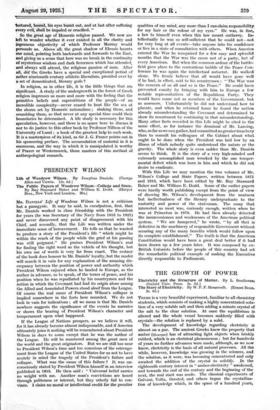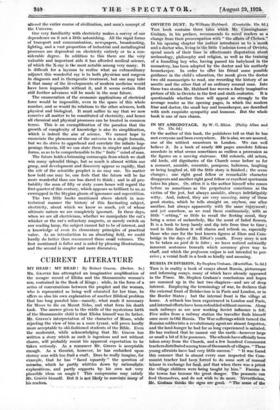THE GROWTH OF POWER
Electricity and the Structure of Matter. By L. Southerner (Oxford Univ. Press. 2e. 6d.) THERE is a very beautiful experiment, familiar to all chemistry students, which consists of making a highly concentrated solu- tion of a very soluble salt and then adding a minute crystal of the salt to the clear solution. At once the equilibrium is altered and the whole vessel becomes suddenly filled with crystals—the solution is replaced by a solid.
The development of knowledge regarding electricity its almost on a par. The ancient Greeks knew the property that amber (ipterrpop) has of attracting light objects when briskly rubbed, which is an electrical phenomenon ; but for hundreds of years no further advances were made, although, as we now know, electricity is the basis of all natural processes. All the while, however, knowledge was growing in the sciences, and the solution, as it were, was becoming concentrated and only awaited the addition of the crystal to solidify. In the eighteenth century interest in " amber-electricity " awakened; and towards the end of the century and the beginning of the next, the real start was made. The classical experiments of GaIvani, Volta, Oersted, and others began the crystalliza- tion of knowledge which, in the space of a hundred years,
altered the entire course of civilization, and man's concept of the Universe.
Our very familiarity with electricity makes a survey of our dependence on it not a little astonishing. All the rapid forms of transport and communication, newspapers, broadcasting, lighting, and a vast proportion of industrial and metallurgical processes are dependent on electricity entirely or to a con-. siderable degree. In addition to this there are the very valuable and important aids it has afforded medical science, of which the X-ray is the most notable among very many. It is difficult for a layman to realize what an extraordinary adjunct this wonderful ray is to both physician and surgeon in diagnosis and in thera'peutic treatment, but one may take it that many of the developments of modern medicine would have been impossible :without it, and it seems certain that still further advances will be made- in the near fUture.
The enumeration of the economic applications of electrical force would be impossible, even in the space of thi's whole number, and so would its relationS to the other sciences, both physical and biological. It must suffice to say that we now conceive all matter to be constituted of electricity, and hence all chemical and physical processes can be treated in common terms. This is an exemplification of the paradox that the growth of complexity of knowledge is also its simplification, which is indeed the aim of science. , We cannot hope to enunciate the phenomena of the universe in a single formula, but we_ do strive to apprehend and correlate the infinite hap- penings therein, till we can state them in simpler and simpler forms, so as to be comprehensible to the " finite " mind of man.
The future holds a brimming cornucopia from which we shall win many splendid things, but so much is almost within our grasp, and development and discoierialiPear so rapidly, that the role of the scientific prophet, is no easy one. No matter how bold one may be, one feels that the future will be far more wonderful than one has dared to think ; and in all pro bability the man of fifty or sixty years hence will regard' the first quarter of this century, which appears so brilliant to us, as enwrapped in the Stygian gloom of ignorance and superstition.
The two little books mentioned above • sketch in non: technical manner the historY of this fascinating subject, electricity, about which we know so much, yet of whose ultimate nature we are Completely ignorant. In these days, when we are all electricians, whether we manipulate the cat's whisker or the car's refractory magneto, 'Or merely, switch on our reading lamp, the subject cannot fail to be of interest, and a knowledge of even its elementary principles of practical value. As an introduction to an absorbing field, we could hardly do better than recommend these small volumes. The first mentioned is fuller and is aided by pleasing illustrations, and the second is simpler and more discursive.



































 Previous page
Previous page